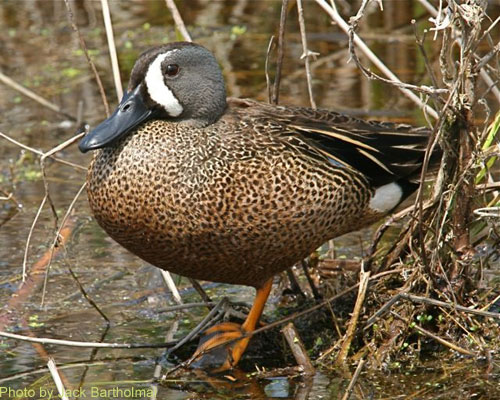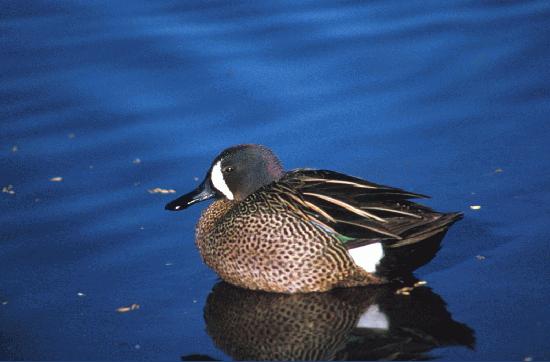
Change Is Good!
Bills
These birds have developed strong beaks in order to compensate for the lack of limbs to gather and hold food. The typical beak of a blue winged teal, and any other waterfowl, is wide and flattened and is called a bill. Surprisingly, the bill is soft except for at the end, where a hard hook is located for the help in acquiring food. The bill also contains bumps along the edge to serve as a strainer for food from the water. Blue winged teal is of the descendents called “dabbling ducks” that feed via tipping forward and submerging their heads under water. The process of eating begins with the duck sucking water through the bill, the food stays inside the bill and the excess water is released out of the sides of the bill. On the edge of the duck’s bill, there are touch receptors that aid in the filtering of good and bad food.

Photograph to the left taken by Jack Bartholmai.
Flying
The Blue winged teal, unlike many other waterfowl species, is known for its extensive flight skills. The speed during flight can average about 50 miles per hour. This duck has precise agility for which it is attributed for. In flight, they can be distinguished by most other waterfowl species from their blue coloring on their wings. Ducks contain hollow bones, allowing for a lighter body weight allowing them to fly. The blue winged teal can spring from the water rather than needing a longer area to take off. These attributes (agility, speed, light weight and strength) allow them to quickly evade any danger that approaches.

Photograph to the left taken by Jerry Kirkhart.
Flotation
One necessary adaptation that the blue winged teal has acquired is the ability to float. Many characteristics contribute to this adaptation. The first reason is because the complex respiratory system in ducks allows them to have air sacs that increase their buoyancy. Another way ducks are able to float is in their feathers. The feathers will trap air between them, allowing them to be more buoyant.
Photograph to the right received from U.S. Fish and Wildlife Services.
Other Adaptations
Lamellae are adaptations of the bill. They are structures on the inside of the bill used for sifting through food and non food items. The blue wing teal may contain up to 120 – 130 lamellae inside the bill.
The blue winged teal, along with all other waterfowl, has feathers that are coated with oils in order to keep themselves warm and dry.
The gizzard is an adaptation that the blue winged teal has acquired because it allows them to grind the food that has been swallowed. It contains small rocks for the breaking down of food. This is necessary because of the lack of teeth on the bill.
